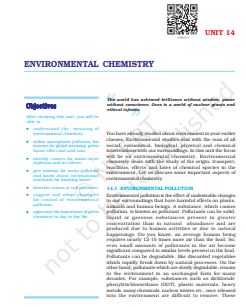‘NCERT Solutions for Class 11 Chemistry Chapter 14‘ PDF Quick download link is given at the bottom of this article. You can see the PDF demo, size of the PDF, page numbers, and direct download Free PDF of ‘Ncert Class 11 Chemistry Chapter 14 Exercise Solution’ using the download button.
NCERT Class 11 Chemistry Textbook Chapter 14 With Answer PDF Free Download

Chapter 14: Environmental Chemistry
14.1 Environmental Pollution
Environmental pollution is the effect of undesirable changes in our surroundings that have harmful effects on plants, animals, and human beings.
A substance, which causes pollution, is known as a pollutant.
Pollutants can be solid, liquid, or gaseous substances present in greater concentrations than in natural abundance and are produced due to human activities or due to natural happenings.
Do you know, that an average human being requires nearly 12-15 times more air than food?
So, even small amounts of pollutants in the air become significant compared to similar levels present in the food. Pollutants can be degradable, like discarded vegetables which are rapidly broken down by natural processes.
On the other hand, pollutants that are slowly degradable, remain in the environment in an unchanged form for many decades.
For example, substances such as dichlorodiphenyltrichloroethane (DDT), plastic materials, heavy metals, many chemicals, nuclear wastes, etc., once released into the environment are difficult to remove.
Pollutants cannot be degraded by natural processes and are harmful to live organisms.
In the process of environmental pollution, pollutants originate from a source and get transported by air or water or are dumped into the soil by human beings.
14.2 Atmospheric Pollution
The atmosphere that surrounds the earth is not of the same thickness at all heights. There
are concentric layers of air or regions and each layer has a different density.
The lowest region of the atmosphere in which human beings along with other organisms live is called the troposphere.
It extends up to the height of ~ 10 km from sea level. Above the troposphere, between 10 and 50 km above sea level lies the stratosphere.
The troposphere is a turbulent, dusty zone containing air, much water vapour, and clouds.
This is the region of strong air movement and cloud formation. The stratosphere, on the other hand, contains dinitrogen, dioxygen, ozone, and little water vapour.
Atmospheric pollution is generally studied as tropospheric and stratospheric pollution.
The presence of ozone in the stratosphere prevents about 99.5 percent of the sun’s harmful ultraviolet (UV) radiations from reaching the earth’s surface and thereby protecting humans and other animals from its effect.
14.2.1 Tropospheric Pollution
Tropospheric pollution occurs due to the presence of undesirable solid or gaseous particles in the air. The following are the major gaseous and particulate pollutants present in the troposphere:
- Gaseous air pollutants: These are oxides of sulfur, nitrogen and carbon, hydrogen sulfide, hydrocarbons, ozone and other oxidants.
- Particulate pollutants: These are dust, mist, fumes, smoke, smog etc.
| Author | NCERT |
| Language | English |
| No. of Pages | 17 |
| PDF Size | 4.5 MB |
| Category | Chemistry |
| Source/Credits | ncert.nic.in |
NCERT Solutions Class 11 Chemistry Chapter 14 Environmental Chemistry
Question 14.1:
Define environmental chemistry.
Answer 14.1:
Environmental chemistry refers to the study of biochemical and chemical processes that occur in our nature. It also delves into the reaction, origin, effects, and transport of the chemical species on our earth.
Question 14.3:
Carbon monoxide gas is more dangerous than carbon dioxide gas. Why?
Answer 14.3:
Both carbon dioxide (CO2) and carbon monoxide (CO) are emitted during the combustion of various fuels. Carbon monoxide is toxic in nature whereas carbon dioxide is non-poisonous in nature.
Carbon monoxide is deemed toxic since it forms a complex with hemoglobin (carboxyhemoglobin), which is more stable than the oxygen-hemoglobin complex. A range of 3–4% of carboxyhemoglobin can decrease the oxygen-carrying capacity of our blood. This can result in weak eyesight, headaches, cardiovascular disorders, and nervousness. A little increase over the above concentration can even be fatal.
Carbon dioxide is harmful only at very high concentrations.
Question 14.8:
What are the harmful effects of photochemical smog and how can they be controlled?
Answer 14.8:
- Photochemical smog is oxidizing in nature since it is composed of NO2 and O3, which are responsible for the corrosion of rubber, stones, metals, and painted surfaces. Photochemical smog also contains formaldehyde, PAN, and acrolein.
- Both ozone and PAN cause eye irritation while nitric oxide (derived from NO2) is responsible for throat and nose irritation. At higher levels, this type of smog can also cause headaches, throat dryness, chest pain, and other respiratory ailments.
Related PDFs
Environmental Chemistry Textbook With Solutions PDF Free Download
